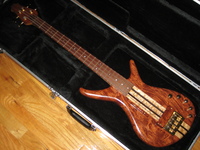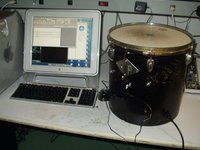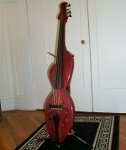When I'm not doing research, I like to build stuff, especially musical instruments. Although I'm mostly in it for the woodworking, I find the problems inherent in instrument interface design interesting as well. Here are some of the things that I've built over the last 7 or 8 years. Aside from some finishing touches on the two most recent projects, the list isn't likely to change any time soon as school keeps me pretty busy. Plus my 275 sq. ft apartment isn't exactly conducive to shop-work!
Tenor Bass (2008-2009)
The Active Tablature Project (2005-2009)
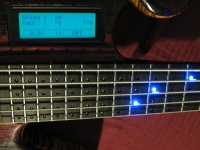
|
This project started about 5 years ago, although I basically didn't work on it at all between 2005 and 2007. It's an electric bass guitar (5 string, 34" scale) with several enhancements aimed at easing and speeding learning. The main idea is to provide a kind of "active tablature" directly on the instrument's fretboard. This is done by embedding 3mm LEDs at each possible fingering position (5 strings x 25 frets = 125 positions/LEDs). The LEDs are connected to on-board hardware which drives them so as to indicate, in real-time, where the player should place their fingers in order to play a song/scale/etc. The electronics are based on the open-source MIOS project, an abstract hardware framework for MIDI based applications. |
HAGUS (2006-2007)
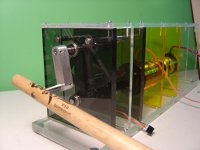
|
The HAptic GUidance System (HAGUS) is a device that I designed and built for my Master's thesis at the MIT Media Lab. It began as a re-thought and re-designed version of the FielDrum, but ended up as a separate project. The underlying idea is the same as with the FielDrum (to explore the effect that physical guidance has on motor learning), but the devices are quite different. Whereas the FielDrum uses magnets for actuation, HAGUS uses a servo motor. |
FielDrum (2006)
ACCORD (2006)
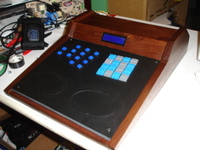
|
This was my class project for MAS960: Principles of Electronic Music Controllers. Basically, it's a MIDI controller/analog synthesizer that provides an abstracted means of constructing three or four-voice chordal sequences. The idea is to provide separate and explicit control over the factors that determine a particular chord (root, type, inversion, etc.). This constrains the space of possible outputs, but in a way that is (hopefully) musically and pedagogically useful. There are controls for some other parameters, like velocity and arpeggiation, as well. |
Bello (2001-2003)
Hammered Dulcimer (2001 & 2003)
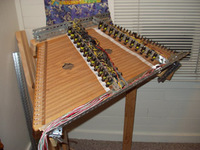
|
This project started off as a traditional 12/11 hammered dulcimer that I built from a kit obtained at a great music store in San Francisco. Eventually I got the idea to try and automate the dulcimer. This was done with some steel from the hardware store, 35 solenoids, and a MIDI-to-parallel port circuit. Each of the 35 positions is mapped to a MIDI note. |
